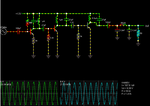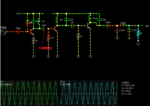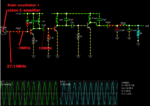
- Joined
- Jul 4, 2009
- Messages
- 16,648
- Helped
- 5,158
- Reputation
- 10,349
- Reaction score
- 5,251
- Trophy points
- 1,393
- Location
- Aberdyfi, West Wales, UK
- Activity points
- 140,896
Just a guess - you have the two 2.2uH inductors parallel to each other, you could be seeing the second transistor oscillate as well as the first one. Think of them as primary and secondary of a transformer. What happens if you rotate one of them 90 degrees, does the output change?
Brian.
Brian.






